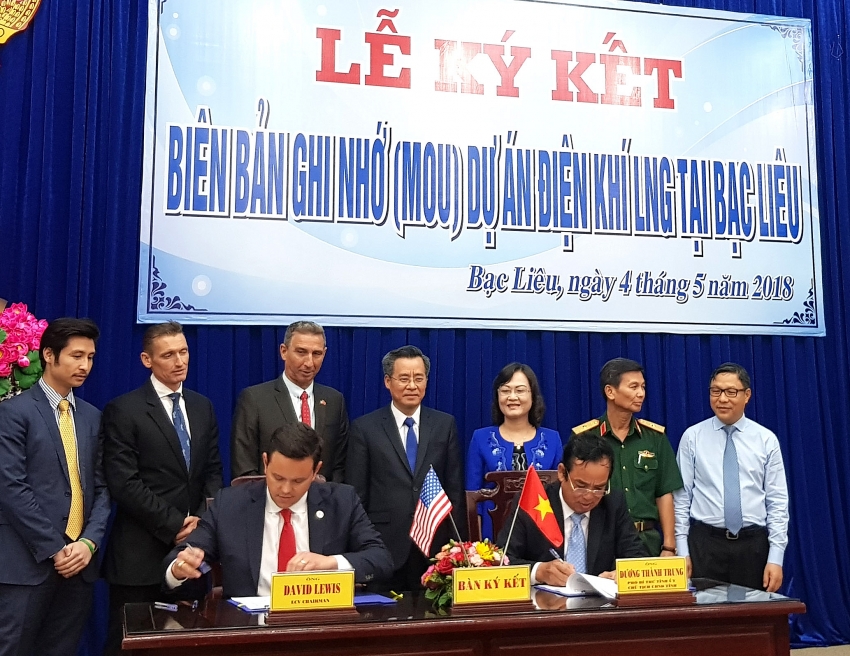LNG market fired up despite obstacles
 |
| LNG market fired up despite obstacles, source: daidoanket.vn |
Energy Capital Vietnam (ECV), a Vietnam-focused project development and asset management company, plans to add another liquefied natural gas (LNG)-fired power plant in the central province of Quang Nam. ECV has signed a memorandum of understanding with the southern province of Bac Lieu on the development of the project worth $4 billion, heating up the race for foreign investors.
However, the road ahead for ECV’s gas-to-power plans is still bumpy. The huge off-shore project, expected to commence operations in late 2021, has not been identified in Vietnam’s energy master plan. Unlike similar projects, imported LNG may be used to fuel the future plant.
According to ECV, it will give first priority to developing its LNG-fuelled power project in Quang Nam. The total capital investment numbers for the project are not available at the moment, but the total generation capacity could be as high as 3,200 megawatts (MW), and it is said that ECV is trying to add this project to the national energy master plan after receiving in-principle support from the Vietnamese government.
“We will engage with global pools of capital to find strategic investment partners for this unique opportunity. Our innovative pathway shortens the time to secure all required licences, certificates, permits, approvals, acceptances, and agreements as per Vietnamese laws within a 12-month period,” said David Lewis, founder of ECV.
“The project demonstrates the Vietnamese government’s commitment to improve energy security and address critical infrastructure needs,” Lewis said. “It represents a new dawn for private investment into infrastructure development within the country.”
The Dallas-based company expects to lead efforts to build the first privately-funded and owned LNG-fired power project in Vietnam, but currently, many foreign investors are in a race to put their gas-to-power projects into operation in the country, so the winner remains to be seen.
According to the Vietnam Energy Association, completing a power purchase agreement (PPA) for each energy project takes investors quite a long time. A PPA between private investors and state-run Electricity of Vietnam for a build-operate-transfer project can take three to four years to complete. The association also pointed out that Vietnam still needs to improve power transmission as well as distribution infrastructure to facilitate new power sellers such as ECV.
In addition, the Vietnamese government has introduced incentives for renewable projects, including wind, solar, and waste-to-power, but an incentive is not available for gas-to-power.
The list of proposed gas-to-power projects in Vietnam includes a number of foreign-invested plans. The US’ AES, which has invested in the $2.1-billion Mong Duong 2 thermal power plant in the northern province of Quang Ninh, is looking to invest in the Son My 2 gas-fired power plant in the south-central province of Binh Thuan.
Also in Binh Thuan, the Son My 1 gas-fired power plant is on the radar of France’s EDF. Meanwhile, Switzerland-based Astra Transcor Energy’s AOT Energy intends to co-operate with Vietnam’s state-run oil and gas group PetroVietnam to build a $650-million LNG complex.
Vietnam’s second largest power producer, PetroVietnam, plans to develop two 750MW combined-cycle gas turbine power plants, Mien Trung I and II in the central province of Quang Ngai, which will use natural gas extracted from the Blue Whale gas field. The field is the largest of its kind in Vietnam, with an estimated 150 billion cubic metres of reserves. The two power plants are expected to begin operations by 2023 and 2024, respectively. The US’ General Electric will work with PetroVietnam to identify the latest technology solutions to provide higher efficiency, lower fuel consumption, and lower emissions for these gas-to-power projects.
Under the revised National Power Development Plan VII, Vietnam will strive to increase its total power generation capacity to around 129,500MW by 2030. Of this, 19,000MW will come from gas-fired power plants, including LNG.
Global research and consultancy group Wood Mackenzie has released a report estimating that Vietnam’s LNG imports will start by 2023 and reach 2.5 million tonnes per annum by 2030. Vietnam will be one of the countries that will import LNG to replace declining domestic gas production.
What the stars mean:
★ Poor ★ ★ Promising ★★★ Good ★★★★ Very good ★★★★★ Exceptional
Related Contents
Latest News
More News
- Government moves to establish International Financial Centre (December 21, 2025 | 21:00)
- Vietnam's IFC to target global investment flows (December 21, 2025 | 18:00)
- Two national hospitals expand capacity with new facilities (December 20, 2025 | 09:00)
- Ha Tinh breaks ground on major Vingroup industrial and energy projects (December 19, 2025 | 18:24)
- EVN launches major power infrastructure projects nationwide (December 19, 2025 | 18:17)
- VAL inaugurates second production line to meet domestic animal feed demand (December 19, 2025 | 16:37)
- Sun Group pioneers urban tram system in Phu Quoc (December 19, 2025 | 15:00)
- Seven major projects launched to drive Hanoi’s next growth phase (December 19, 2025 | 14:00)
- Securing capital and efficiency for Vietnam’s 2026-2030 growth ambitions (December 17, 2025 | 10:00)
- Vietnam bucking trend in the global M&A landscape (December 16, 2025 | 14:20)

 Tag:
Tag:




















 Mobile Version
Mobile Version